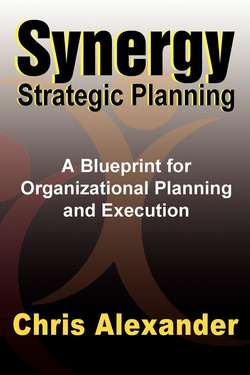Читать книгу Synergy Strategic Planning - Chris Alexander - Страница 20
На сайте Литреса книга снята с продажи.
6. Does the vision take all the organization’s potential for accomplishment into account?
ОглавлениеThis is a complex question but can be simplified by asking your group: “What would success look like in five to ten years taking all of our potential for accomplishment into account?” A free-flowing and creative debate should form the foundation for this question—allowing “out-of-the-box-thinking.” Thoughts and ideas should be listed and revisited, and no area should be excluded. You will be surprised at the hidden desires and subconscious underpinnings that reveal themselves. Following are examples of how well this question works.
Some years ago I conducted a strategic planning retreat for Amylin Biotech Corporation, then headed up by Ted Green and Dr. Tim Rink, who both supported the visionary focus of this question. Interestingly, one of the outcomes from this question, and the lively debate around it, was that the senior executive team—for the first time—reached a meeting of minds that the true vision for Amylin was to become a fully fledged pharmaceutical company, and not a boutique biotech company. This resulted in the renaming of the company to Amylin Pharmaceuticals, Inc. and, in turn, clarified its vision: core values and goals.
Amylin Pharmaceuticals has gone on to become one of San Diego’s best places to work and their current mission is as follows:
“Amylin Pharmaceuticals is a biopharmaceutical company committed to improving lives through the discovery, development and commercialization of innovative medicines.”
I worked with several companies in the building industry who made significant changes by asking this question. Like Amylin, they reaped enormous benefits in leadership focus, levels of quality, and customer satisfaction, thus reducing costs and increasing revenues. It is common knowledge that the building industry worldwide has undergone enormous transformation. In California, the SB800 Bill (arbitration bill) ratified in the State Assembly in 2003 required homebuilders to improve the quality of their product and services to homebuyers.
When I consulted with these companies and went through the vision guideline questions, it was soon discovered that many internal changes were needed to be in compliance with the SB800 Bill. Because of this, I guided several companies through the process of building customer-driven cultures, which meant that we needed to align systems and processes, and focus all staff on a shared destiny.
The first step was conducting several Synergy Team Power Retreats to lay the foundation for change. All staff members from sales, accounting, construction, customer service, land acquisition, planning and engineering, and the entire senior executive team attended the retreats. To demonstrate commitment to the shared destiny, the senior executive team attended more than one retreat. This formed a foundation of solid communication, willing attitudes, and a productive, transparent work environment— shifting mentality and creating a critical mass of ownership to the shared destiny.
Simultaneously, we conducted a series of strategic planning workshops that went through an initial education step and then a series of workshops that included interactive group dynamic exercises resulting in building a vision statement, a clear set of values, and broader generic goals (e.g., improving quality, customer service, and teamwork). Once each executive team reached this stage and the vision was completed and ratified, it was circulated throughout the company for input and approval. Some changes were made, mostly “word-smithing” in nature, until the vision statement was finally published and distributed.
“We have always been committed to building trust, communication, and respect with our customers and employees. Our customer-care program is a sentiment to our dedication of providing world-class service and helping people to achieve the American dream.”
SCOTT GRUGEL, DIVISIONAL PRESIDENT, INTERIOR SPECIALISTS, INC.
